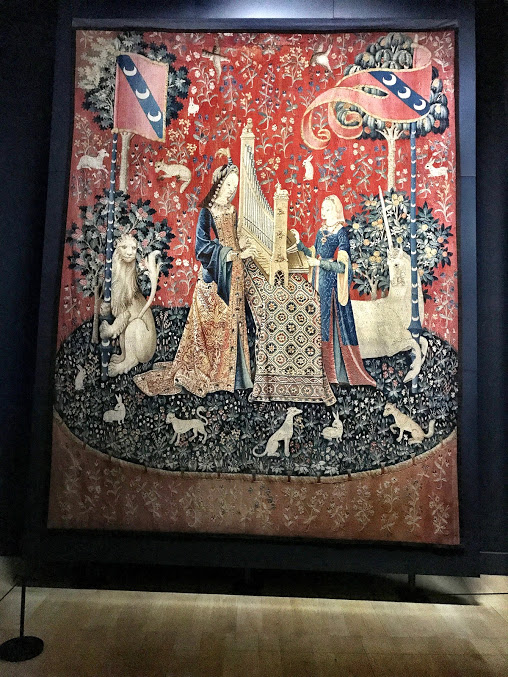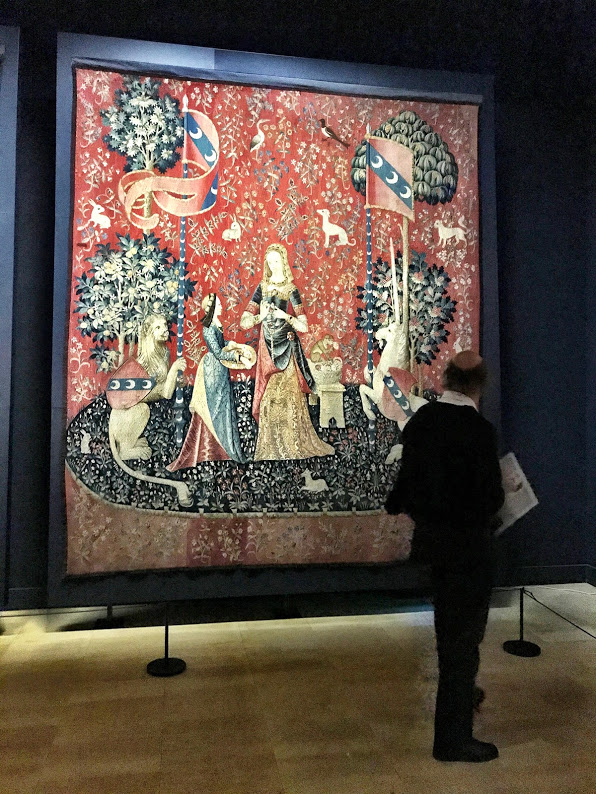The Lady and the Unicorn rained magic upon me.
A Mon Sevl Desir – According to my will only.
There she stood—a queen, a goddess, emerging from her royal pavilion. She planned to return the magnificent jewels once bestowed upon her to a faithful servant for safekeeping. Fantastical bestiary of the forest ensure her passage to and from this place. The lion and the unicorn, watching over the doorway. The dog and the monkey, companions underfoot.
Before me hung the sixth, most enigmatic, panel of the famed La Dame à la licorne tapestries. At the Museé de Cluny in Paris, I found myself deeply overwhelmed for the second time that day.
Exhaustion and jet lag, I told myself as dabbed at my wet cheeks.
Then, my eyes rose up to land upon the words woven in the pavilion. They rose up in the background of the tapestry. I leaned into my constant state of verklempt and understood. France with all of the moments I chose to open fully to would transpire according to my will only.
“A mon seul desir,” I whispered. It was if my lady and her unicorn whispered hello in return.

The Lady and The Unicorn – The Anticipation
I’d waited years to take in the absolute wonder of this allegorical series of tapestries. They have been the source of heated debate and endless interpretation since their rediscovery at Château du Boussac in 1841.
I was still in the throes of my first twenty-four hours in France. I would only come to understand the significance of the tapestries almost two weeks later. The thrill. Now, I know. This proved the first piece in a provocative puzzle of revolution, duality, and mysteries of the French Renaissance. It shoots me right back to that moment.
As I write this, I wish only that I’d spent more time at the Cluny. These magnificent works, spoke as so much else would through the places and artifacts I discovered in my research.
No one entirely agrees on what these mysterious panels mean, who created them, or why they were crafted. The general consensus is that the six panels are an allegory of the senses. (Sight, Sound, Smell, Taste, Touch, and the final sense of Heart or Soul).
Oh, how I want to get into all of the academic knowledge surrounding them. To me, the debate and the analysis make me ravenous for more. However, I’d much rather tell you about my own fictional interpretation that leads to these being included in the novel.

My Story of the Story
I’ve long pursued a more fanciful interpretation. Totally fictional, as I have nothing more than my imagination and anecdotal research to thread together the concepts I’ve chosen to pair up. One in which these panels represent the story of a lost time and the lost society of the Sibylline.
The mythology of the Sibyls is more than 11,000 years old. It weaves its way through at least a dozen civilizations of North Africa, Mesopotamia, and Europe. Five appear on the ceiling of the Sistine Chapel. The Vestal Virgins are thought tied to them. The Sibylline Books, great records of the oracular visions of the ancient world, are thought lost to the politics and religious fervor of the 5th Century. They were re-written later to suit the re-telling of history through the lens of Abrahamic religions. For generation after generation, kings and pharaohs sought them out. They relied upon their oracular powers to guide everything from warfare to marriage, and then they were wiped from history.

Medieval Mysteries
From King Arthur to the Dames Blanches, the Medieval era is steeped in mysticism. The line between this world and the next revealed itself as little more than a light veil. All manner of creature and being often passed through it. I like to entertain the idea that these tapestries reveal the existence of the Sibylline to us.
Many today attribute illuminated manuscripts with prayers. They were often bursting with spells and rituals. They showed us bestiaries from which headless armies of Blemmyes walked. Dragons of all manner took to the sky to nothing more than fantasy. I am not so easily convinced that we have not somehow severed ourselves from the passages that once were open between the world.

Were The Sibylline Real?
Evidence of the Sibylline mounting a resurgence of their culture and extrasensory abilities is ample within the Middle Ages. These tapestries to me reveal their revered place in Medieval society. Particularly in France where Humanism and the exploration of the self was a thing for common folks and royalty alike.
Within their world, a new Sibyl could rise and take her place as the oracle of humanity every thousand years. The last Sibyl had been brutally murdered at the beginning of the 5th Century.
So, the time of da Vinci and Michelangelo, of Francois I and Marguerite, was the time once again for a Sibyl to rise. This female-driven society may have remained cloistered in abbeys, underground, hidden away while rebuilding for a millennia.

Tales In The Tapestries
Through each sense elaborated upon in the tapestries, the Sibylline reveal their ability to renew the world. Maybe to end humanity’s suffering. Possibly to bring us all back to a greater understanding of the power that lives within ourselves.
Away from the Christian interpretation of these panels, there is plenty of pagan and ancient goddess iconography. The baby rabbits are associated with Artemis. They cannot be killed in the hunt as they are under her protection. The chalice is an ancient goddess symbol of fertility and rising up from the Mother blood.
The crescent moon within the banners of the Lady and the Unicorn is the epitome of the divine feminine power on Earth.
That one might develop spiritually enough to manifest and fortify personal power by their own will was widespread in the 15th Century. This esoteric link between human and divine is not unlike the new age movements today.
We all can begin to understand why panels such as these and women such as the Sibylline vanished.

Final Notes on The Lady and the Unicorn
Returning back to the final panel and the phrase sewn into the pavilion.
Nearly everything in that time period, especially if it might have subverted the doctrine of those who murdered to keep their dogma in a primary place of power, was encoded to be deciphered by those who knew the way.
I played for a long time with the anagram of those words until the code I needed to emerge from it made itself evident:
A Mon Sevl Desir – According to my will only.
Voir des l’ansem: See the Ansem, the descendants of angels.
